Living in Maryland and saw some blue-colored birds but are not sure which ones they were?
No matter how often you see the blue-colored ones, it is always a thrilling experience, bound to fill you with a sense of freedom, imagination, inspiration, and sensitivity.
Examples of blue birds in Maryland include the blue jays, indigo buntings, blue grossbeaks, several species of swallows, including barn and tree swallows, purple martins, great blue herons, belted kingfishers, eastern bluebirds, and many others.
Some of them, like the blue jays, great blue herons, and belted kingfishers will stay year-round there, while others, like the indigo bunting and eastern bluebirds, will migrate south from Maryland when the winter comes.
Blue Birds In Maryland
Indigo Bunting
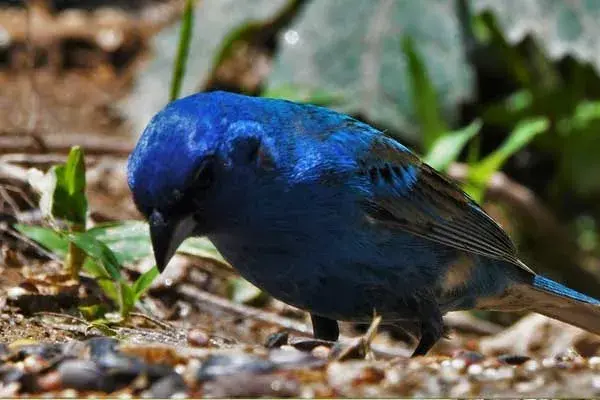
Scientific name: Passerina cyanea
Lifespan: 10 years
Wingspan: 7-9 in
Color: Bright and rich blue
Range In Maryland: Summer residents throughout Maryland
Also known as blue bunting, the indigo bunting is a small seed-eating bird and one of Maryland’s more common breeding songbirds. Found throughout the state, look for them in the open field and brush habitats.
Indigo buntings might be hard to see, but if you learn their song, you will have a better chance of spotting these beautiful bright blue birds. Males will whistle a bright, lively song of sharp, clear, high-pitched notes that lasts about 2 seconds.
Between September and November, indigo buntings will leave Maryland and move south, to Mexico, South, and Central America.
They are migratory birds that travel during the night, using stars to navigate.
Adult males have a vibrant blue plumage during summer, with slightly richer blue colors on their heads. They will often sing from the tops of trees and shrubs along hedgerows and wooded edges.
During the winter months, they are brown, just like females are year-round.
Males are sometimes mistaken for blue grosbeaks; however, blue grossbeaks are larger, have thicker bills, and have slightly different plumage colors.
Indigo buntings are territorial birds and omnivores that feed on insects, seeds, and berries. Because of their bright blue color, many people consider indigo buntings to symbolize wisdom and spiritual realization.
These birds usually mate for life; occasionally, they may switch partners within a single breeding season.
A group of buntings is called a “decoration”, “mural”, or “sacrifice”.
Blue Grosbeak
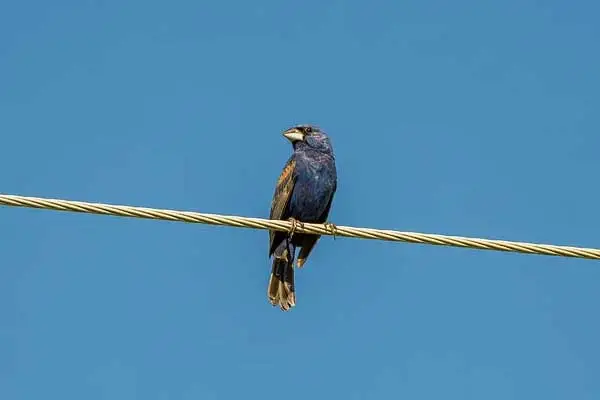
Scientific name: Passerina caerulea
Lifespan: 6-7 years
Wingspan: 10-11 in
Color: Rich blue
Range In Maryland: Summer resident in eastern Maryland
This medium-sized migratory blue bird nests in eastern and central parts of Maryland; during winter it migrates to Central America.
Blue grosbeak, just like indigo bunting, prefers early successional habitats with vigorously growing grasses, forbs, shrubs, and trees. That’s why, in agricultural areas like Maryland’s Eastern Shore, you will find these species along field edges, hedgerows, tidal march boundaries, and fallow fields.
Besides Maryland, blue grosbeak is also common in northern Mexico and the southern United States.
It is a stocky songbird with a very large, triangular silver beak that almost covers the whole face.
Adult male blue grosbeaks have a deep blue plumage color, tiny black masks in front of the eyes, and chestnut wing bars. Females have rich cinnamon-brown colors. The color of the head is a rich blue.
These interesting birds will occasionally use snakeskin when building their nests to scare off predators.
To attract the female, the male will sing, and when a female chooses him as her mate, he will sing louder than before.
Blue grosbeaks are omnivores that often feed on the ground, feasting on insects and seeds of weeds, grasses, and other plants.
Eastern Bluebird

Scientific name: Sialia sialis
Lifespan: 6-10 years
Wingspan: 9-12 in
Color: Royal blue above
Range In Maryland: Year-round resident throughout Maryland
The eastern bluebird is a small North American migratory thrush with a big, rounded head, large eyes, and alert posture.
These birds are the most widespread of the three bluebird species and can be found in the open country with scattered trees, farms, and roadsides in eastern parts of North America. It is the only of the 3 bluebird species that can be regularly seen in Maryland.
In case you decide to go searching for eastern bluebirds, meadows, old fields, and golf courses would be good places to start. They typically sit in the open, on power lines or along fences, with an alert, vertical posture.
Marvelous birds to capture in your binoculars, male eastern bluebirds have vivid royal blue head and back plumage and warm red-brown and white breasts.
Just like their cousins, the mountain bluebirds, the eastern bluebirds are cavity nesters that love nest boxes.
They are very social birds living in flocks with over 100 individuals but also very territorial.
To attract a female, a male bluebird will sing over 1,000 songs per hour; it sings without opening its beak wide.
These birds are omnivores that mostly feed on insects, including grasshoppers, crickets, beetles, caterpillars, and some fruit.
The Eastern bluebird is the official bird of Missouri and New York.
Blue Jay
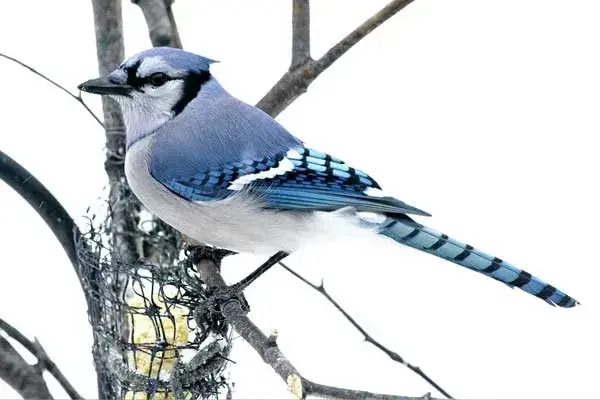
Scientific name: Cyanocitta cristata
Lifespan: 7 years
Wingspan: 13-17 in
Color: Blue above
Range In Maryland: Year-round resident throughout Maryland
Easy to identify by its noisy calls, large size, and bold colors, the blue jay is one of the most popular and famous blue birds in Maryland. It can be found in most of the eastern and central parts of the United States.
Blue jays are Maryland’s year-round residents, often found near oaks, in forests, woodlots, towns, cities, and parks. These birds are also commonly found in Baltimore.
Both sexes have similar plumage – a mix of black, blue, and white plumage above that is white or light gray underneath. On top of the head, there is a large crest.
The blue jay is not a state bird in any US state; it is, however, the mascot of a Major League Baseball team called the Toronto Blue Jays.
These social songbirds are very intelligent and can use tools and imitate the sounds of predators.
Blue jays mate for life and work together to build a nest for their young. When the female is sitting on the eggs, the male will feed and take care of her.
Blue jays are omnivores that mostly feed on seeds, berries, nuts, and occasionally insects.
Barn Swallow

Scientific name: Hirundo rustica
Lifespan: 4 years
Wingspan: 12.5-13.5 in
Color: Cobalt blue above
Range In Maryland: Summer resident throughout Maryland
Maryland is home to several species of swallows, which are all small, distinctively shaped birds. Pointed wings and forked tails are physical traits that most swallows possess and are adaptations for speedy flight.
The barn swallow is one of the largest swallow species found in Maryland. Although rare in the state in late fall and winter, you will be able to spot it as it comes back to Maryland in late March.
In early fall, this long-distance migratory bird flies from North American breeding grounds to winter in Central and South America.
The barn swallow is also the most widespread species of swallow in the world.
This bird with cobalt blue wings and head, also has a rusty-orange throat and forehead, and a pale orange chest and underside.
As mentioned, these blue birds are easy to recognize by their long, slender, and deeply forked tails. Males and females look similar – the female’s tail is a little less forked.
According to legend, the barn swallow got its forked tail because it stole fire from the gods and brought it to people. This made the gods angry so they threw a firebrand at the swallow, burning its middle tail feathers.
Barn swallows are insectivores that catch and eat insects in the air as they fly.
Tree Swallow
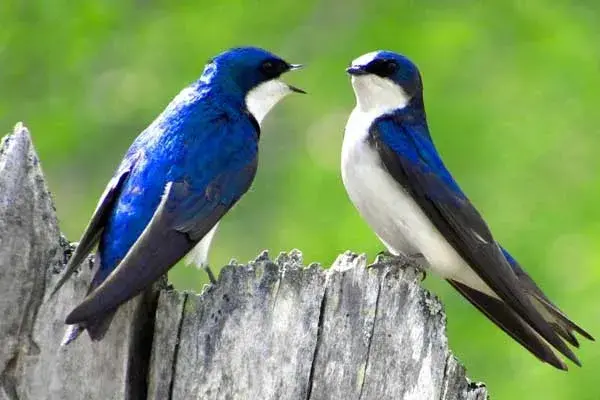
Scientific name: Tachycineta bicolor
Lifespan: 3 years
Wingspan: 12-14 in
Color: Metallic blue above
Range In Maryland: Summer resident throughout Maryland
Tree swallows are small migratory songbirds with long, pointed wings and short, squared, or slightly notched tails.
These birds have almost metallic greenish-blue backs and heads, together with white throats, breasts, and bellies.
Tree swallows breed in the United States and Canada – they begin migrating south in July and August to western Mexico and Central America. During summer they can be found in Maryland, Pennsylvania, Florida, Tennessee, Kansas, Missouri, Ohio, and a few other states.
Another welcoming sign of spring in much of North America, tree swallows are social animals whose flocks can include thousands of birds.
If you decide to try to identify this species, the best habitats to start your quest will be open spaces such as wetlands or farm fields of Maryland.
Look along utility wires, shrubs, and nest boxes for these perched birds. Tree swallows like to spend a lot of time sitting and flying around those. They are very vocal species, so listen for their sweet, chirping calls.
They are omnivores that feed on insects, mollusks, spiders, and occasionally on fruit, berries, and seeds.
Want more than 20 examples of small blue-colored birds? Read this article.
Blue-gray Gnatcatcher
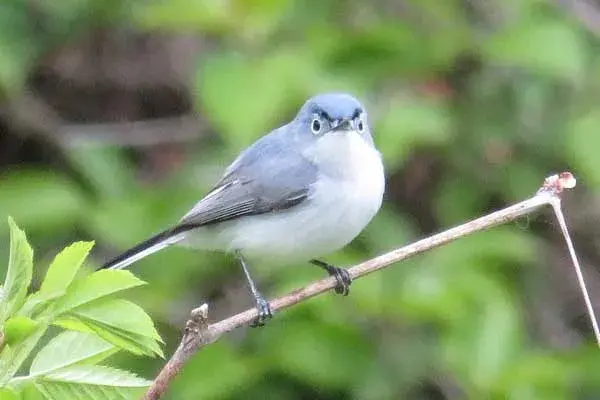
Scientific name: Polioptila caerulea
Lifespan: 3-4 years
Wingspan: 6 in
Color: Pale blue-gray
Range In Maryland: Summer resident throughout Maryland
Blue-gray gnatcatchers are one of the “angriest” blue birds in Maryland. That’s because of the dark, V-shaped “eyebrow” marking male blue-gray gnatcatchers have during the breeding season. This makes them look like they are constantly annoyed.
Males also have a pale blue-gray color of the heads and the upperparts, and white underparts. Females are less blue, while juveniles are greenish-gray.
The blue-gray gnatcatcher is a very small songbird native to North America. It is a monogamous bird that mates for life.
Males can be particularly aggressive and will chase larger birds away from feeding areas or their nesting territory.
In summer, these small birds can be found in open woods, oaks, pines, and thickets of Maryland, Pennsylvania, Northern California, Nevada, Utah, Texas, Oklahoma, eastern Kansas, Iowa, southern Wisconsin, and many other eastern parts of the United States.
Read More: 25+ beautiful black and white birds found in Colorado
Black-throated Blue Warbler
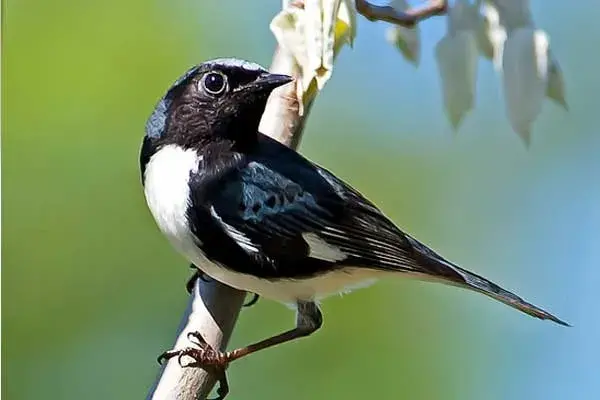
Scientific name: Setophaga caerulescens
Lifespan: up to 10 years
Wingspan: 7.5 in
Color: 7.5 in
Range In Maryland: Summer resident in some western parts of Maryland
Black-throated blue warbler is a small, well-proportioned bird with a sharp, pointed beak. It breeds in dense hardwood forests of the northeastern United States and eastern Canada.
In Maryland, this blue bird can be occasionally found in the western parts of the state. From August to October, black-throated blue warblers will begin migrating south, toward the Greater Antilles (Cuba, Puerto Rico, Jamaica, and the Cayman Islands). That might also be your chance of spotting these birds as they fly over Maryland.
Adult males are unmistakable; they have a deep midnight blue color above, white bellies, and black faces and sides. They do not change their appearance as the season changes; black-throated blue warblers can be easily recognized in the fall and the spring.
When first discovered, since males and females look so different, people used to describe them as two separate species.
Black-throated blue warblers are cute-looking and very small songbirds weighing just 0.34 oz.
Cerulean Warbler

Scientific name: Setophaga cerulea
Lifespan: 6 years
Wingspan: 7-9 in
Color: Clear sky blue
Range In Maryland: Summer resident in central and western parts of Maryland
These small blue-colored birds are common in deciduous forests with tall trees in central and western Maryland. In fall, cerulean warblers will begin migrating south, to winter in Andean mountain forests, from Colombia south to Bolivia.
They have one of the longest migrations of any small passerine bird, traveling almost 2,500 miles between breeding grounds in eastern North America to nonbreeding habitats of northern South America.
Cerulean warblers can be difficult to identify since they forage, sing, nest, and roost high in the canopy of mature forests.
In case you encounter one, you will notice a small, round beak, a shorter tail, pale cerulean blue and white upperparts, a black necklace across the breast, and black streaks on the back and flanks.
The population of this migrant songbird is declining and is considered threatened.
Cerulean warblers are insectivores (carnivores) that primarily feed on insects such as flies, beetles, weevils, and caterpillars.
Read More: 15 amazing green-colored birds of Florida
Belted Kingfisher
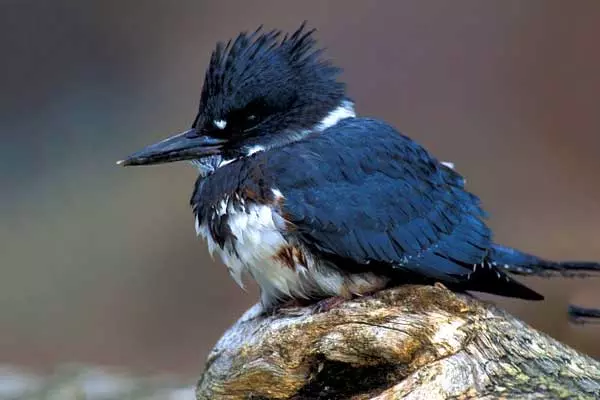
Scientific name: Megaceryle alcyon
Lifespan: 6-14 years
Wingspan: 19-23 in
Color: Blue-gray
Range In Maryland: Year-round resident throughout Maryland
This large, conspicuous water kingfisher is native to North America.
Belted kingfisher has a large head, a shaggy crest on the top and back of the head, and a straight, thick, pointed beak. The upper plumage is blue-gray while the underparts are white. Females are blue with orange chests.
Often found around streams, lakes, bays, and coasts, belted kingfishers are very territorial and males will often chase intruders away.
If looking for a belted kingfisher, you will hear it before you see it – listen for its distinct and loud rattling or chattering call. This bird lives in Maryland throughout the entire year, taking advantage of bodies of water that remain open during the winter months.
Belted kingfishers are carnivores that dive to catch fish and crayfish with their heavy beaks. In Maryland, they mostly feed on a variety of small fish species, including sticklebacks, mummichogs, stone rollers, and juvenile trout.
Belted kingfishers will also eat mollusks, crustaceans, amphibians, and lizards.
They can’t digest bones so just like owls, belted kingfishers will regurgitate the undigested pieces as pellets.
Read More: Examples of big birds in Texas
Purple Martin
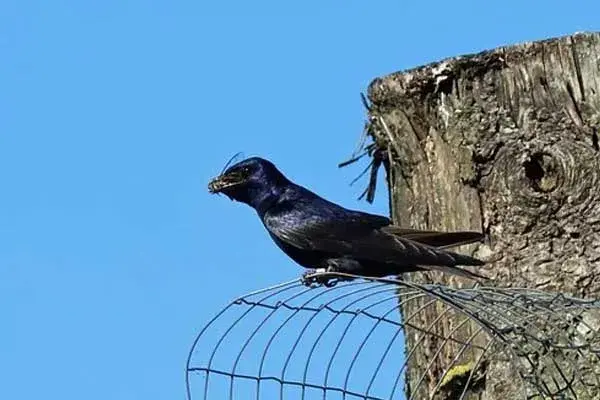
Scientific name: Progne subis
Lifespan: 5-7 years
Wingspan: 15 in
Color: Dark blue-purple
Range In Maryland: Summer resident throughout Maryland
The purple martin is the largest swallow in North America. Known for its chattering song and aerial acrobatics, it is one of the most beautiful blue birds found in Maryland.
Purple martin will spend winter in the rainforests of Brazil and then undertake a 7,000-mile-long migration trip back into the eastern United States and Canada.
As a sure sign that spring is close, the first purple martins of the year can be spotted in Maryland around March. Look for male purple martins that are scouting out potential nest sites. These scouts will start arriving in late March to early April.
If you want to attract purple martins to your backyard, make sure to put up houses a few weeks before the earliest arrival.
When talking about appearance, the bird has a slightly hooked bill, a short and forked tail, and long, tapered wings.
Adult males are dark overall with a purplish-blue shimmer visible at close range. Depending on the light and angle, their head color may appear to be royal blue, navy blue, or deep purple. Females are grayer with shine on the crown and back.
Purple martins will typically build their nests out of straw, twigs, and pine needles. They are very social and colonial birds – the largest roosting colony ever discovered had over 700,000 birds!
Purple martins are carnivores (insectivores) that feed on fire ants, bugs, flies, butterflies, dragonflies, grasshoppers, crickets, moths, wasps, bees, cicadas, spiders, and termites.
They are also excellent fliers that can reach flight speeds of over 40 mph.
Read More: List of biggest birds in Michigan
White-breasted Nuthatch
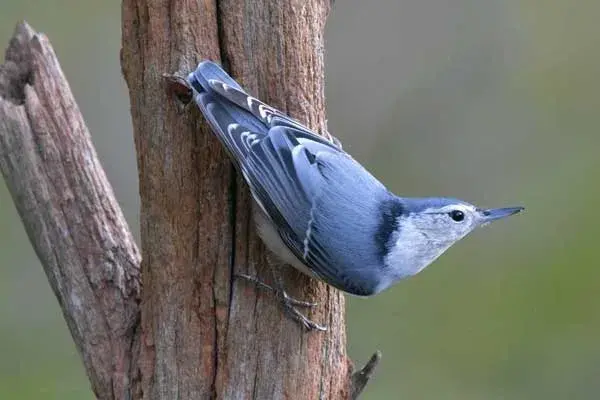
Scientific name: Sitta carolinensis
Lifespan: 2 years
Wingspan: 11 in
Color: Gray-blue above
Range In Maryland: Year-round resident throughout Maryland
The largest nuthatch in North America, the white-breasted nuthatch is a medium-sized bird with clean blue-gray and white plumage. The male and female look very much alike, the only difference is that the female has lighter color. White-breasted nuthatches have small tails and almost no neck which makes them look very stocky.
These quirky and loud birds got their name from the way they crack open seeds – they will jam their seeds and nuts into tree bark, and then whack it with their beaks to open the seeds.
A common sight throughout Maryland, except in some areas of the Lower Eastern Shore, white-breasted nuthatches can be found in forests and open areas in most of the United States and parts of Canada and Mexico.
Read More: Loons commonly found in Canada
To hear them, listen for a rapid series of low, nasal, whistled notes on one pitch “whi-whi” or “who-who”. Often, males will sing rapidly in the spring when they are trying to attract a mate.
White-breasted nuthatches are omnivores that feed on insects and seeds.
Red-breasted Nuthatch
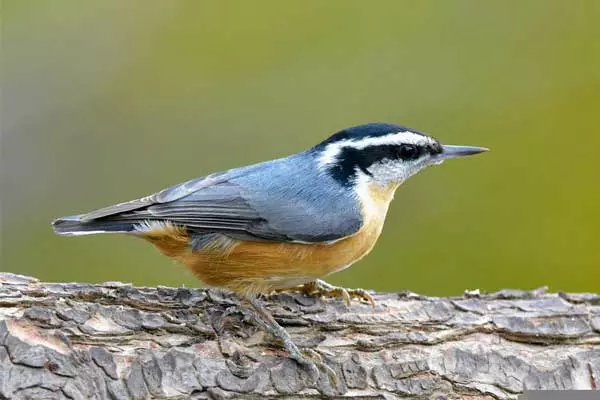
Scientific name: Sitta canadensis
Lifespan: 6 years
Wingspan: 8.5 in
Color: Blue-gray
Range In Maryland: Winter resident in eastern Maryland
These small songbirds will spend winter in eastern parts of Maryland, although some might spend the entire year in central parts of the state.
You will recognize these active birds by blue-grey upperparts, cinnamon underparts, white throats, and black stripes over the eyes. Red-breasted nuthatches have straight grey beaks, long toes and claws, and black crowns. Their call is high-pitched, nasal, and weak “yank-yank”.
Unlike white-breasted nuthatches who prefer living in deciduous forests, red-breasted nuthatches can be mainly seen in coniferous woods and mountains.
They mainly feed on insects and seeds, especially from conifers. Red-breasted nuthatches will hoard excess food by wedging nuts into the bark and then hammering them in with their beaks.
They begin to migrate south earlier than many other birds, starting in early July.
Read More: Examples of blue and red-colored birds
Great Blue Heron
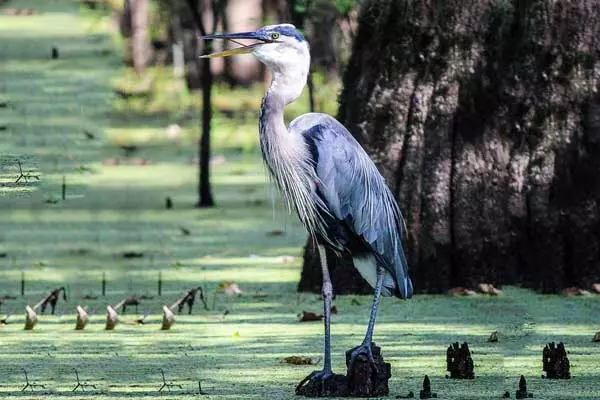
Scientific name: Ardea herodias
Lifespan: 15 years
Wingspan: 5.5 to 6.6 ft
Color: Gray-blue
Range In Maryland: Year-round resident throughout Maryland
The largest of North American herons and one of Maryland’s largest birds, the great blue heron is easy to identify by its large yellow-orange bill, short black plumes on its head, and black and chestnut pattern on the shoulders.
It is quite common near the shores of open water and in wetlands. During the flight, they will hold their necks in an S-shape with legs trailing behind.
Despite their large size, great blue herons are fast birds that can reach speeds of around 30 mph.
They are monogamous only for a single season and will go through some interesting courtship rituals, locking and rubbing their bills on the feathers of the other bird before mating.
Both parents will take turns in incubating the eggs, and after hatching, the chicks can fly at only 2 months of age.
They nest in colonies called heronries that can occasionally have more than 500 nests.
Great blue herons are carnivores that feed on fish, amphibians, reptiles, invertebrates, small mammals, and even other birds. These birds will slowly stalk their prey in shallow waters, striking with lightning speed, catching them with their long and sharp beaks.
Great blue herons are one of the 12 biggest birds that live in Ohio.
Little Blue Heron
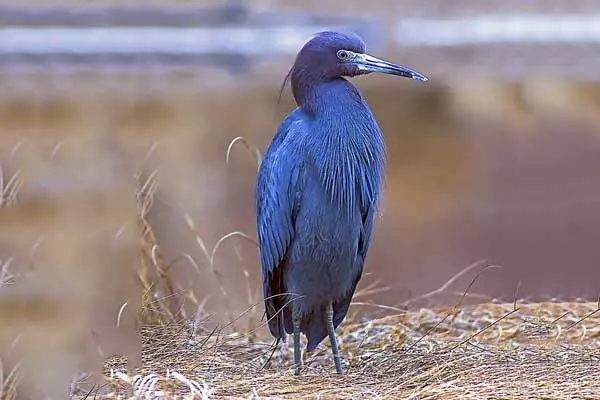
Scientific name: Egretta caerulea
Lifespan: up to 7 years
Wingspan: 39-41 in
Color: Blue-purple
Range In Maryland: Summer resident in some eastern parts of Maryland
This medium-sized bird is a part-time resident of Maryland, preferring the coastal areas around the Atlantic Ocean and the Chesapeake Bay. In the state, they are the only medium-sized heron that is all dark blue-purple.
Colored in moody blues and purples, little blue herons are found around marshes and estuaries in the Southeast. Both sexes look similar while the juveniles are completely white in their first year.
Little blue herons have a row of “teeth” along their middle toes that they use to scratch their heads, necks, and throats.
They nest in colonies, often around other species of herons, egrets, and wading birds.
Little blue herons usually forage alone, stalking their prey methodically in shallow water. They are carnivores that feed on fish, frogs, lizards, snakes, turtles, spiders, crustaceans, small rodents, and insects.
Read More: 15+ examples of large blue birds from around the world
Summary
This concludes our list of blue birds in Maryland.
There are plenty of types of blue-colored birds in Maryland, including jays, several types of swallows, kingfishers, herons, gnatcatchers, cardinals, and many others.
Maryland has large areas of different natural habitats that make great homes for a wide range of bird species, especially the blue-colored ones.
Next time, should you see these birds in person, you should be able to recognize any of them with ease!
And if you enjoyed our article, here are other popular reads on birds: 16+ beautiful birds that have red-colored necks and 15+ examples of green birds found in Florida